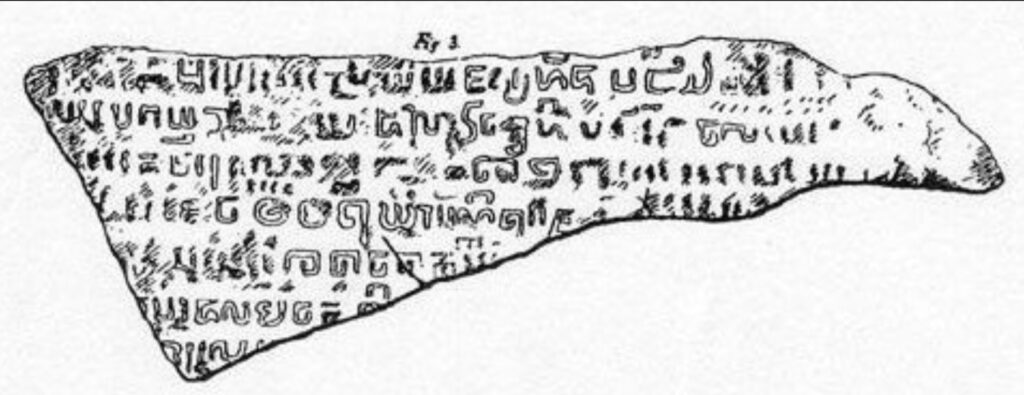Among the many forgotten writing systems of the world, one particularly heartbreaking case comes from Singapore, as recorded by the British colonial administrator Frank Swettenham in the late 19th century. He related a story about an ancient script found in the region—one that could have provided invaluable insights into the early history of Southeast Asia. Tragically, due to ignorance and disregard for its significance, this script was destroyed by a British official, erasing a potential key to Singapore’s past forever.
The Discovery of the Singapore Stone
Swettenham’s account tells of a large sandstone slab, discovered near the mouth of the Singapore River, covered in an unidentified script. This slab, known as the Singapore Stone, had long been known to the local Malays, who viewed it as an important historical artifact. The inscription, possibly dating back to the 10th to 14th century, was carved in an unknown script—one that might have been Old Javanese, Sanskrit, or even an entirely lost writing system.
At the time, scholars had little knowledge of early Singaporean history. The region was a crucial crossroads of trade, influenced by Indian, Chinese, and Malay cultures. If the script had been studied in depth, it could have provided clues about early trade networks, forgotten languages, or even the origins of Singapore before the arrival of Sir Stamford Raffles in 1819.
The Destruction of the Stone
Instead of preserving or studying this mysterious inscription, Captain D.H. Stevenson, the acting Settlement Engineer, ordered the destruction of the Singapore Stone in January 1843. His justification? The large slab obstructed the entrance to the river and needed to be cleared to make way for Fort Fullerton, a British defensive structure.
As a result, the script—possibly the last remaining link to an unknown civilization—was irreversibly destroyed. Only a few fragments of the stone survived, one of which is now housed in the National Museum of Singapore. However, no one was able to document or decipher the full inscription before it was lost.
What Could the Script Have Been?
While we can never know for certain, scholars have speculated that the script might have been:
- A form of Old Javanese or Kawi script, used in inscriptions across the Malay Archipelago during the Srivijaya and Majapahit periods.
- A Sanskrit-based script, reflecting Indian influence in early Singapore.
- A completely unknown writing system, possibly representing a now-extinct language from pre-colonial Singapore.
If the Singapore Stone had been studied rather than destroyed, it might have provided a crucial piece of evidence about the region’s early inhabitants and their connections to wider trade networks.
A Cautionary Tale of Cultural Destruction
The story of the Singapore Stone serves as a stark reminder of how colonial powers often erased indigenous history, either through neglect or outright destruction. Similar tragedies have occurred worldwide, from the burning of the Library of Alexandria to the Spanish destruction of Maya codices.
Stevenson’s decision to destroy the Singapore Stone was likely made without malice—he was simply focused on colonial infrastructure. However, his actions had irreversible consequences, erasing a potential key to Singapore’s ancient past.
Could a Similar Discovery Happen Again?
Despite this loss, Singapore and Southeast Asia continue to be rich archaeological grounds. Ancient inscriptions have been found in nearby regions, such as:
- The Kedukan Bukit inscription (7th century) in Sumatra, written in Pallava script.
- The Talang Tuo inscription, detailing Buddhist teachings from the Srivijaya empire.
- Other inscriptions on stones and copper plates found throughout the Malay Archipelago.
If another inscribed artifact were to be discovered in Singapore, modern scholars would have far better tools to preserve, study, and decipher it. Unlike in the colonial era, there is now a greater appreciation for Southeast Asian history, and efforts are being made to reconstruct lost narratives.
A Lost Story That Should Not Be Forgotten
The unknown script of the Singapore Stone remains a ghost of the past—something that almost revealed itself but was carelessly erased. While we may never recover what was lost, this story should serve as a lesson in historical preservation and a reminder that every inscription, no matter how small, could hold the key to understanding our shared human past.
Who knows? Perhaps somewhere in the jungles of Southeast Asia, another lost script is waiting to be found—one that, this time, will be preserved rather than destroyed.


